Jupiter's at opposition this week. Close and bright, it shines like a midnight version of Venus. No matter your scope, the biggest planet is always a crowd-pleaser.
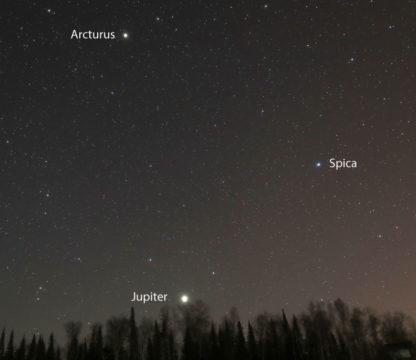
Bob King
Like a candle in the dark, Jupiter gleams pale yellow low in the southeastern sky at dusk. It reached opposition on May 8th and is now closest to the Earth for the year. Close vs. far for Jupiter is significant: Today the giant planet is only 658 million km away compared to 962 million last October at solar conjunction. Then, its apparent diameter was just 30.6″; now it's a chunky 44.8″.
Close is also a word observers like to hear because it's synonymous with bigger and brighter. And given the small apparent size of planets and their even tinier features, opposition means seeing all the juicy details.
Jupiter is more giving than other planets because it's the biggest to begin with and boasts bold features visible in even the smallest telescope.
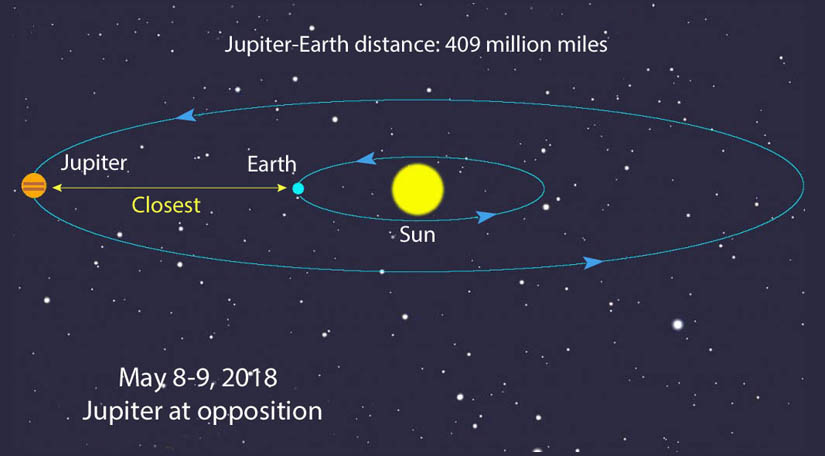
Bob King
Jupiter lacks a solid surface. It's all atmosphere and clouds patterned out in a series of light and dark bands called zones and belts. The North and South Equatorial Belts (NEB and SEB) are the first features you're likely to see when you point a 60-mm or larger telescope at the planet. These mainstays (mostly — rarely, one or the other will temporarily disappear) look like parallel tire tracks on either side of Jupiter's equator.
Zones define regions of colder air and are bright upwellings of clouds composed of primarily of ammonia ice. Belts are where gas descends; their dark red color is believed to be due to trace amounts of sulfur, phosphorus, and other organic compounds.
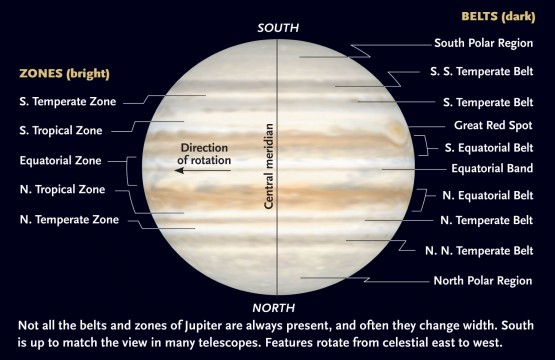
S & T
One of the first things everyone wants to see on Jupiter is the Great Red Spot (GRS). The planet's rapid rotation swings this swirling storm into view about once every 9 hours and 50 minutes. Then there are the moons. Is there a sweeter sight in a small scope? I still remember the rush of wonder I felt when I first saw them at age 11.
The four bright Galilean satellites shuffle around the planet at different rates according to distance to create myriad arrangements pleasing to the eye. Every couple days a moon will casts its shadow on Jupiter's cloud tops or tread into the giant's shadow and disappear in a total eclipse. With antics like these, Jupiter never disappoints.
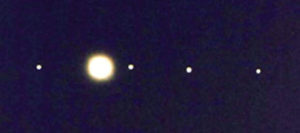
Bob King
At opposition, the planet rises around sundown and remains visible all night long. Because the Sun now sets after 8 o'clock local time from many locations, Jupiter doesn't clear the turbulent lower atmosphere until after 10:30 p.m. local time. If that's too late for you, just wait. The planet rises 4 minutes earlier every night and will soon be well-placed at a more convenient hour.
Because Jupiter is in Libra at declination –15°, observers in mid-northern latitudes will have to be more deliberate than their southern counterparts in catching those infrequent nights of good seeing when the planet sits still and bares all.
Make a point to stop by every clear night even for a minute or two. You never know when you'll hit the jackpot.
Binoculars up to a 3-inch telescope
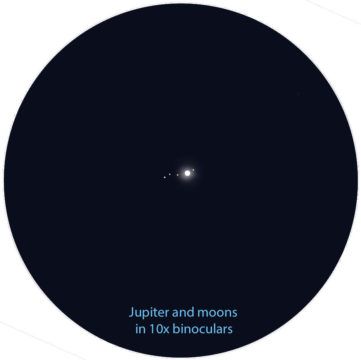
Stellarium
At 7× and higher magnification binoculars will show Jupiter as a disk and all four of its brightest moons — Io, Europa, Ganymede, and Callisto. The latter two orbit farthest from the planet and are usually the easiest to spot because they regularly sidestep its glare. If you routinely observe Jupiter, it won't be long before you'll catch sight of the other two. Plan your hunt when each is at or near greatest elongation.
Occasionally, only one or two moons will show. The others are there, of course, but hidden from view either in front or behind Jupiter.
Binoculars will also provide a splendid look at Jupiter when it pairs up with the wide double star Alpha (α) Librae, better known as Zubenelgenubi (zoo-ben-el-je-NEW-bee). The planet passes the star twice, first in early June and again in mid-August. They'll be closest on August 15–16 at just 34′ apart, or about one full Moon diameter.
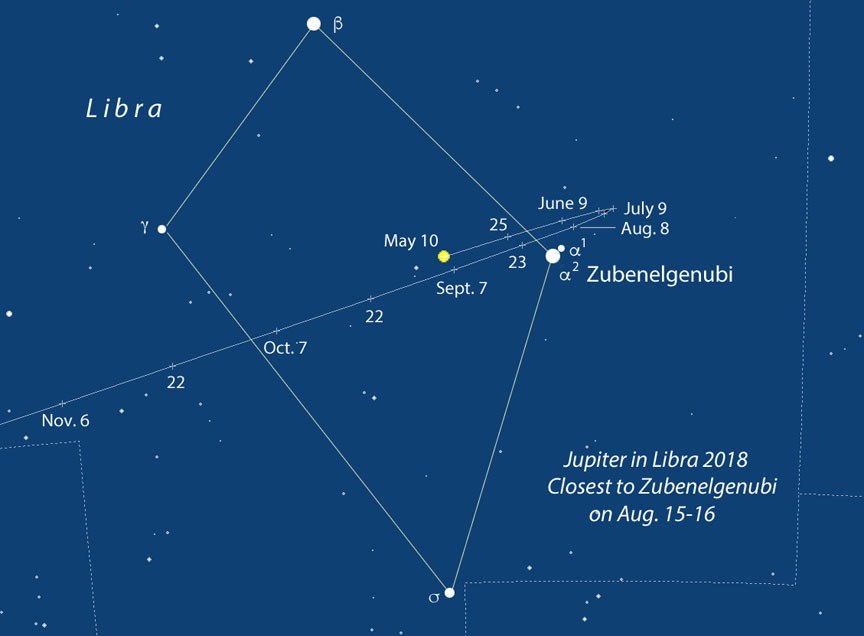
Chris Marriott's SkyMap with additions by author
A small telescope will easily show all four moons right up to the edge of the planet. When Jupiter appears sharp and steady, you can even watch shadow transits of the larger moons, Ganymede and Callisto, using a magnification of 75× or higher. A shadow transit occurs when a moon passes between our line of sight and Jupiter; the shadow cast looks like a tiny black dot against the bright clouds. Well outside of opposition, when the Sun is off to one side of the planet, the shadow either precedes or follows the moon and appears well before or after the moon passes in front of the planet.
You'll can also watch a moon pass in and out of Jupiter's shadow in eclipse or see it slowly covered by the planet's limb during an occultation. To identify which moon is which any time and night of the year, check out Sky & Telescope's Jupiter's Moons. Select a date, then click calculate for a nifty map showing the position of each. A separate table lists transits, occultations and eclipses. Or print out a copy of this wigglegram showing the moons' positions for the month of May.
With a 6- to 8-inch telescope
Experienced observers might see the GRS in a smaller telescope, but I recommend a 6-inch telescope for a good view in 2018. Things were different 50 years ago when the GRS was more than twice the size of Earth. Jupiter's Cyclopean eye has now contracted to just 1.3 Earths, and its shape has grown rounder, more apple than grape. Go to Sky & Telescope's GRS Transit Times site for lists of times when the Spot transits Jupiter's central meridian, i.e., when we face it square on. The GRS is well-placed for at least an hour before and after that.
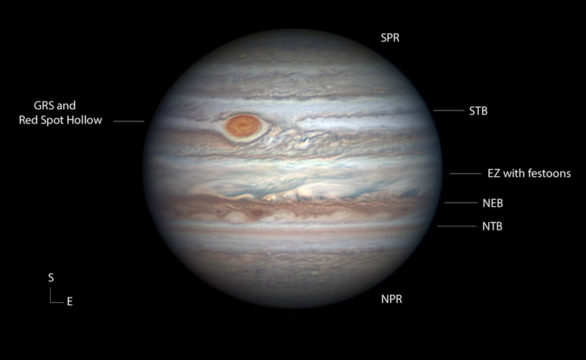
Christopher Go
Fortunately, despite the shrinkage, the Red Spot continues to show a healthy, red hue, so it stands out from everything else on the planet. In good seeing you should have no problem detecting it with a magnification of 100–150×.
Medium-sized telescopes really start to open up the view. For starters, you can watch shadow transits of all four moons as well as see the tiny disks of the larger satellites for a brief time as they move onto and off Jupiter's disk during shadow transits. Again, the larger moons, Ganymede and Callisto, are easier to see against the planet than Io and Europa. Also watch for:
- The frayed and bumpy edges of the NEB and SEB
- At least two additional delicate dark belts — the North and South Temperate Belts
- Festoons — dark, arc-shaped cloud swirls within the bright Equatorial Zone
- North and South Polar Regions (NPR, SPR) — usually drab gray in amateur scopes, but revealed in all their stormy glory by NASA's Juno probe
- Jupiter's oval shape — it's wider at the equator than pole-to-pole
- Moons as disks of varying size using a magnification of 200× or higher in good seeing — they range from tiny Europa at 0.84″ across to 1.4″ for Ganymede
- Io's orange color, an indicator of sulfur-based, volcanic lavas
With a 10- to 16-inch telescope
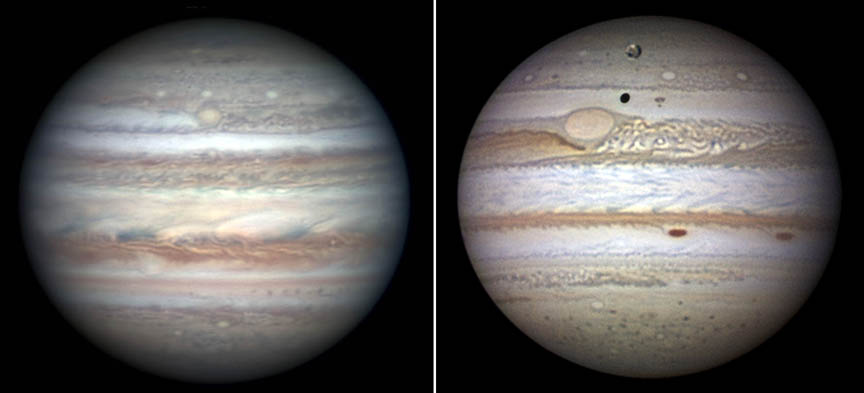
Christopher Go (left) / Damian Peach
You'll never run out of things to see with a big scope though a larger aperture requires better atmospheric seeing to work at full capacity. Jupiter generously repays the patient observer. Look for:
- GRS: look for the darker "button" in the center of the storm as well as the Red Spot Hollow, a lighter area in which the spot sits
- North and south components of the SEB — darker southern half, lighter-toned northern half
- Mottled disturbance in the SEB following (east of) the GRS
- The chocolate-red color of the equatorial cloud belts, especially the NEB
- Additional cloud belts and zones, particularly in the temperate latitudes and just south of the North Polar Region (NPR)
- Oval BA — a long-lived, mini-GRS, a.k.a. Red Spot Jr., formed when several smaller ovals merged. Notable for its pale pink color. The oval, located between the South and South South Temperate belts at ~40° longitude (System II), can be glimpsed using 150× or higher magnification on good nights.
- Smaller storms called white ovals and dark barges are often found along the northern edge of the NEB. The ovals are often low-contrast; the barges stand out better against the pale clouds.
- A 5th moon, Himalia. Himalia is Jupiter's 6th largest moon but only manages a paltry magnitude 15.0 this season. Its extended and tilted orbit (29.6° to Jupiter's equator) takes it a long way out from the planet. Seek it at greatest elongation to lessen the planet's glare. To find it, create your own map using a sky-charting software program. Stellarium, a free program for Mac and Windows available at stellarium.org, includes Himalia. If you use Stellarium also download the additional star catalogs into the program to expand its magnitude range to 15. After setting up, click on the configuration icon, then select the Tools tab to grab 'em.
Finding larger features like belts and zones is relatively easy, but smaller storms like Oval BA drift across the longitudes pushed by the planet's powerful winds. To find a smaller object you'll not only need to know which belt or zone it occupies but also its longitude. Jupiter has two basic systems of longitude: System I for the faster-rotating equatorial regions, and System II for the slower polar latitudes. For Oval BA, I listed its System II longitude. To determine which longitude is squarely in view (on Jupiter's meridian), use this calculator.
Watching the dance of the moons and changing cloud patterns makes Jupiter one of the most rewarding planets. Steady skies to all!
Resources
-
- Jupiter 2017/2018 Season by Christopher Go
- ALPO Jupiter Section
- Juno mission to Jupiter latest news and photos
 6
6









Comments
Tom-Reiland
May 10, 2018 at 7:41 pm
Bob, Jupiter is probably the best planet for both new and experienced amateur astronomers to observe. Your article does an excellent job of pointing that out. I remember observing it with a 2.4" Gilbert Reflector in the 1950s and again in the early 1970s. The Red Spot was very easy to see in that scope. When I got back into astronomy in the '70s, I bought a home-made 6" f/6.6 reflector off of one of the members of the AAAP (Pittsburgh astronomy club) and the Red Spot was easy to view with that scope. Nov 10, 1975 was that last time it was that easy to see for me. Myself and AAAP members Jim Mullaney, Bob Schmidt and Wade Barbin noticed that we could not see the Spot in the Autumn of 1976. It had disappeared. The Hollow was all that was left. Jim pointed out that this had happened in the past. I don't recall when we were able to see it again, but it has not been anything like it was 43 years ago. The past two or three years it has been more distinct, but not the deep red it was in the early '70s. As you mentioned, it is smaller and I've been able to see it with relative ease so far this year, even when it is near the limb of the planet. Here's hoping that it keeps growing..
You must be logged in to post a comment.
Bob KingPost Author
May 13, 2018 at 4:13 pm
Tom,
Yes, here's hoping! I saw it two nights ago clearly in good seeing. The nice bright pink-red gave it away.
You must be logged in to post a comment.
Graham-Wolf
May 10, 2018 at 10:05 pm
Hi Bob
Adding my own praise to Tom's!
Jupiter steadily getting brighter in the post midnight skies at Dunedin, NZ.
Easy to find Libra, thanks to Jupiter.
Easy also to find Spica, thanks to Jupiter, again! It's sure up there, its sure getting brighter. We also have the Martian Opposition later this year, too. This is a good prelude for that. Happy observing!!
Graham W. Wolf at 46 South, Dunedin NZ.
You must be logged in to post a comment.
Bob KingPost Author
May 13, 2018 at 4:15 pm
Thanks, Graham. You too! Can't wait for Mars, but at least we have Jupiter as an hors d'oeuvre.
You must be logged in to post a comment.
Roger-Keith
May 12, 2018 at 1:10 am
Shouldn't " A shadow transit occurs when a moon passes between our line of sight and Jupiter; the shadow cast looks like a tiny black dot against the bright clouds." include "...between the Sun and Jupiter...", since the quoted description is a transit?
You must be logged in to post a comment.
Bob KingPost Author
May 13, 2018 at 4:13 pm
Hi Roger,
When we face Jupiter in May at opposition, the Sun is at our backs, so if a satellite passes between our line of sight and the planet, it's essentially the same as between the Sun and Jupiter. However, well outside of opposition, you're correct. Moons still cast shadows but off to the side, not within our direct line of sight. Admittedly, I chose a more generic explanation for shadow transit phenomena because I was describing them around the time of opposition, so I should have included a qualifier. For that reason, I will add it in. Thank you!
You must be logged in to post a comment.
You must be logged in to post a comment.